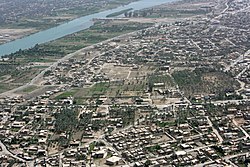Ramadi, Iraq
|
Ramadi الرمادي Ar-Ramādī |
|
|---|---|
 |
|
| Ramadi's location inside Iraq | |
| Coordinates: 33°25′11″N 43°18′45″E / 33.41972°N 43.31250°E | |
| Country |
|
| Governorate | Al Anbar Governorate |
| Government | |
| • Mayor | Ibrahim al-Aousej |
| Elevation | 160 ft (50 m) |
| Population (2011) | |
| • Total | 375,000 |
| Time zone | GMT+3 (UTC+3) |
| Postal code | 31001 |
Ramadi (Arabic: الرمادي; BGN: Ar-Ramādī; also formerly rendered as Rumadiyah or Rumadiya) is a city in central Iraq, about 110 kilometers (68 mi) west of Baghdad and 50 kilometers (31 mi) west of Fallujah. It is the capital of Al Anbar Governorate. The city extends along the Euphrates and is the largest city in Al-Anbar. Founded by the Ottoman Empire in 1879, by 2011 it had a population of about 375,000 people, the vast majority of whom are Sunni Arabs from the Dulaim tribal confederation. It lies within the Sunni Triangle of western Iraq.
Ramadi occupies a highly strategic location on the Euphrates and the road west into Syria and Jordan. This has made it a hub for trade and traffic, from which the city gained significant prosperity. Its position has meant that it has been fought over several times, during the two World Wars and again during the Iraq War and Iraqi insurgency. It was heavily damaged during the Iraq War, when it was a major focus for the insurgency against occupying United States forces. Following the withdrawal of US forces from Iraq in 2011, the city was contested by the Iraqi government and the extremist group Islamic State of Iraq and the Levant (ISIL) and fell to ISIL in May 2015. On 28 December 2015, the Iraqi government declared that it had re-taken Ramadi from ISIL, that government's first major military victory since the loss of Ramadi some seven months earlier.
Ramadi's population was reported by the World Food Programme to number 375,000 people in 2011, though the number is likely to have decreased since then given the impact of the Iraq war and insurgency. Its population grew rapidly during the last half of the 20th century, from 12,020 people in 1956 to 192,556 in 1987. The population is very homogeneous, over 90 per cent Sunni Arab. The vast majority of its population come from the Dulaim tribal confederation, which inhabits Syria and Jordan as well as Iraq and has over a thousand individual clans, each headed by a sheik selected by tribal elders.
...
Wikipedia

